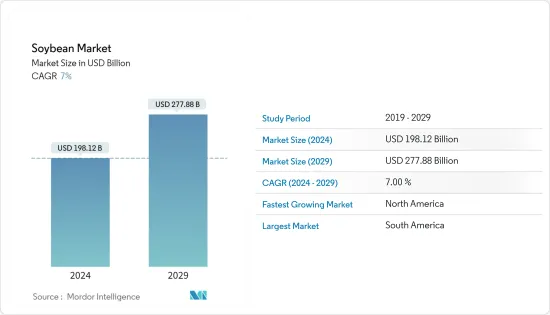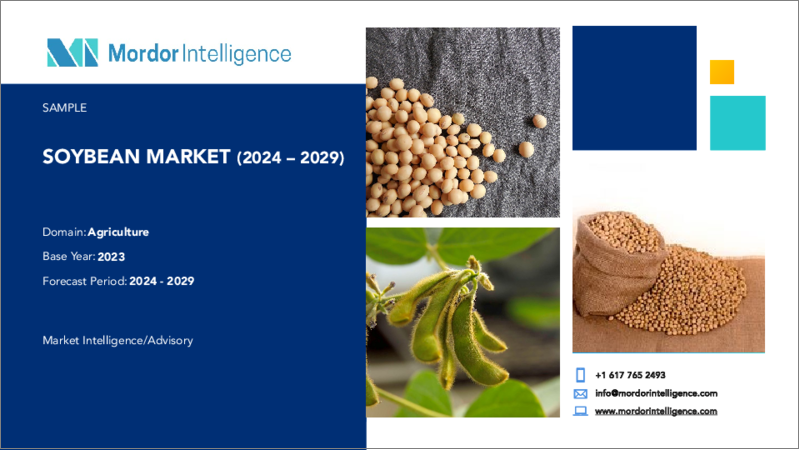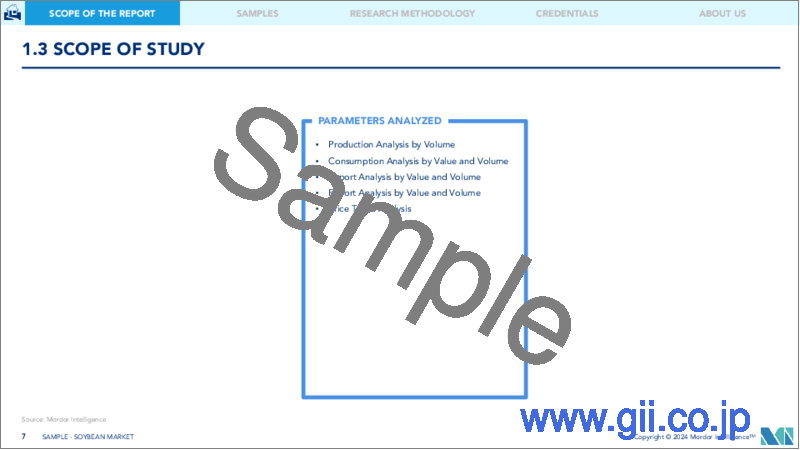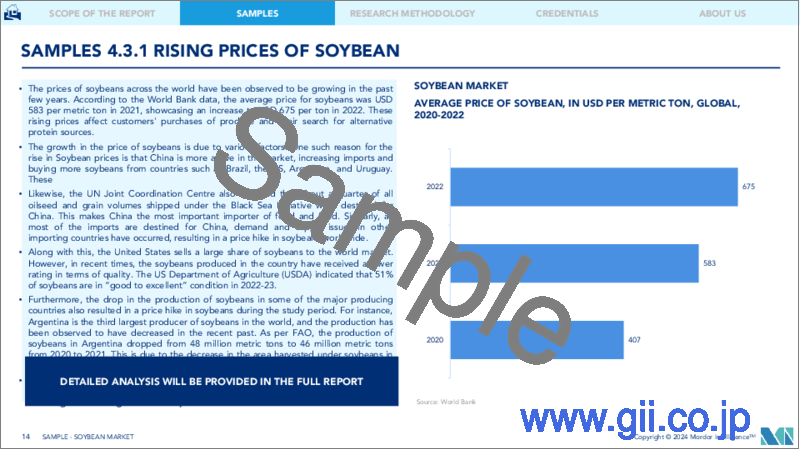|
|
市場調査レポート
商品コード
1444035
大豆:市場シェア分析、業界動向と統計、成長予測(2024-2029年)Soybean - Market Share Analysis, Industry Trends & Statistics, Growth Forecasts (2024 - 2029) |
||||||
カスタマイズ可能
適宜更新あり
|
|||||||
| 大豆:市場シェア分析、業界動向と統計、成長予測(2024-2029年) |
|
出版日: 2024年02月15日
発行: Mordor Intelligence
ページ情報: 英文 125 Pages
納期: 2~3営業日
|
- 全表示
- 概要
- 目次
大豆市場規模は2024年に1,981億2,000万米ドルと推定され、2029年までに2,778億8,000万米ドルに達すると予測されており、予測期間(2024年から2029年)中に7%のCAGRで成長します。

主なハイライト
- 大豆の生産量はここ数年増加し続けています。大豆の収穫面積の増加に伴う生産量の増加は、世界の市場を牽引する可能性があります。 FAOによると、世界の大豆生産量は2019年に3億3,600万トンで、2020年には3億5,300万トンに増加しました。さらに、大豆は油の抽出、食用作物、動物の飼料として使用できます。料理業界ではサラダの調味料やその他の調理用途によく使用されます。大豆は、低コレステロール、低脂肪の食品代替品、タンパク質が豊富な農産物としても人気があります。乳糖不耐症の人にとって優れた乳製品の代替品です。米国国立医学図書館によると、ほぼすべての人間は乳児期以降に乳糖を消化する能力の約65%を失います。そのような場合には、大豆の摂取が役立ちます。幅広い用途が世界の大豆市場を牽引しています。
- 米国、ブラジル、アルゼンチン、カナダ、パラグアイ、ウルグアイは世界最大の大豆生産国および輸出国であり、世界生産量の85.0%以上を占めています。長年にわたり、米国は世界の主要な大豆生産国および輸出国でした。しかし、南米はブラジルを筆頭に大豆生産の最大の市場となりました。 FAOによると、土壌の質、気象条件、水の利用可能性によって促進された好ましい生育条件により、2020年にブラジルでの大豆生産量は劇的に増加しました。大豆市場は、植物性たんぱく質が豊富に含まれた食事の人気により、西側諸国でビーガニズムの採用が増加していることによって牽引されています。生活水準の向上による消費者の健康意識の高まりも市場にプラスの影響を与えました。
大豆市場動向
大豆副産物の需要の増加
大豆粕や油粕などの大豆副産物の需要はここ数年増加しました。栄養価の高さから消費者の人気が高まり、市場が拡大しています。先進国の消費者の可処分所得の増加とこれらの国の大豆生産性の向上は、大豆副産物の需要に貢献しました。 USDAによると、2020年の米国の大豆油生産量は1,130万トンで、2018年の1,080万トンから増加しました。国内の大豆油の需要は一次産品の生産に貢献し、これは予想されています予測期間中に市場を牽引します。
これに加えて、大豆の製品別である大豆レシチンは、湿潤剤として、粘度や結晶化を軽減し、コレステロールを管理し、塩素を強化するために使用できるため、人気の食品成分です。これは、栄養補助食品、アイスクリームや乳製品、新生児用粉ミルク、パン、マーガリン、その他のインスタント食品に重要な用途を持つ食品成分です。さらに、大豆粕は独特のアミノ酸組成を有しており、穀類タンパク質の代替品として使用できます。さらに、中国のような急成長国における動物性タンパク質の需要の増加により、大豆粕などの高タンパク質の動物飼料の需要も増加しました。長期的には成長率が土地単位当たりの収量の増加を上回っているため、大豆生産の需要が増加しています。したがって、大豆粕は動物の飼料や人間の消費用に使用されます。タンパク質強化食品の需要が高まっている主な理由は、その健康上の利点と、世界市場における家畜、牛、反芻動物、その他の動物の数の増加です。
南米が世界の輸出市場を独占
南米は世界市場における大豆の最大の輸出国です。ブラジル、アルゼンチン、パラグアイは世界の大豆供給量の50%以上を占めています。南米では、ブラジルが2020年の最大の大豆輸出国で、世界の総輸出量の44.4%を占め、次いでアルゼンチン、パラグアイとなった。ブラジルの大豆生産量は2017年に1億1,470万トンで、2020年には1億2,170万トンに増加しました。この生産量の増加により、今後数年間の大豆輸出が増加します。 2020年のブラジル通貨安により、大豆価格は国際市場での競争力を高めました。大豆栽培に対する農家の意識の高まりと、この地域での栽培環境の整った環境により、大豆の生産が増加しました。大豆などの油糧種子に対する国内および世界の需要は長年にわたって増加しており、大豆の価格と農家の収入にプラスの影響を与えています。米中貿易戦争の影響でブラジルから中国への輸出が増加しました。
アルゼンチンは世界トップの大豆油と大豆ミールの輸出国です。たとえば、ITC貿易地図によると、アルゼンチンは2021年に6兆106億9,100万トンの大豆油を輸出しました。さらに、パラグアイは世界で4番目に大きな大豆輸出国です。パラグアイ大豆輸出会議所のデータによると、同国は生産する大豆の半分以上を輸出しており、同国の経済は原料の海外への出荷に大きく依存しています。家畜数の増加と大豆粕の需要の増加により、アジア太平洋地域の南米諸国と欧州からの輸出が増加しています。
大豆産業の概要
その他の特典
- エクセル形式の市場予測(ME)シート
- 3か月のアナリストサポート
目次
第1章 イントロダクション
- 調査の前提条件と市場の定義
- 調査範囲
第2章 調査手法
第3章 エグゼクティブサマリー
第4章 市場力学
- 市場概要
- 市場促進要因
- 市場抑制要因
- バリューチェーン/サプライチェーン分析
第5章 市場セグメンテーション(生産分析、金額・数量別の消費分析、金額・数量別の輸入分析、金額・数量別の輸出分析、価格動向)
- 地域
- 北米
- 米国
- カナダ
- メキシコ
- 欧州
- ロシア
- イタリア
- ウクライナ
- スペイン
- アジア太平洋
- 中国
- インド
- 日本
- オーストラリア
- 南米
- ブラジル
- アルゼンチン
- パラグアイ
- 中東とアフリカ
- 南アフリカ
- エジプト
- サウジアラビア
- 北米
第6章 市場機会と将来の動向
The Soybean Market size is estimated at USD 198.12 billion in 2024, and is expected to reach USD 277.88 billion by 2029, growing at a CAGR of 7% during the forecast period (2024-2029).

Key Highlights
- The production of soybeans kept on increasing in the past few years. The increase in production along with an increase in the area harvested under soybean is likely to drive the market globally. According to FAO, the world soybean production is 336 million metric tons in 2019 increased to 353 million metric ton in 2020. Additionally, soybean can be used for extracting oil, as an edible crop, and as feed for animals. It is frequently used in the culinary business as a salad condiment and for other cooking applications. Soybean is also popular as a low-cholesterol and low-fat food substitute and protein-rich produce. It is an excellent dairy substitute for lactose-intolerant persons. According to the US National Library of Medicine, nearly all humans lose approximately 65% of their ability to digest lactose after infancy. So in such cases, the consumption of soybean helps. The wide usage is driving the soybean market globally.
- The United States, Brazil, Argentina, Canada, Paraguay, and Uruguay are the largest producers and exporters of soybean globally, accounting for more than 85.0% of the global production. For many years, the United States was the world's major producer and exporter of soybean. However, South America became the largest market for soybean production with Brazil being the leading country. According to FAO, in 2020, soybean production increased dramatically in Brazil, attributed to the favorable growing conditions augmented by the soil quality, weather conditions, and water availability. The soybean market is driven by the increasing adoption of veganism in western countries due to the popularity of plant-rich proteins in the diet. The increased health awareness among consumers due to the higher standard of living also impacted the market positively.
Soybean Market Trends
Increased Demand for the Byproducts of Soybean
The demand for soybean by-products like soybean meal and oil cakes increased over the past few years. The high nutritional value of the products enhanced their popularity among consumers, and it is increasing the market. The increased disposable income of consumers in developed countries and the improved soybean productivity in these countries contributed to the demand for soybean byproducts. As per the USDA, in 2020, soybean oil production in the United States was recorded at 11.3 million metric ton, increasing from 10.8 million metric ton in 2018. The demand for soybean oil in the country contributed to the production of commodities, which is anticipated to drive the market during the forecast period.
Along with this, soy lecithin a by-product of soybean is a popular food ingredient because it can be used as a wetting agent, to reduce viscosity and crystallization, to manage cholesterol, and to enhance chlorine. It is a food ingredient with significant applications in dietary supplements, ice creams and dairy products, newborn formulae, bread, margarine, and other convenience foods. Furthermore, soybean meal has a unique composition of amino acids and can be used as an alternative to cereal proteins. Additionally, the demand for high-protein animal feedstuffs like soybean meal increased due to the rise in demand for animal protein in quickly developing nations like China. Because growth rates are outpacing increases in yield per land unit over the long run, there is an increasing demand for soybean production. Therefore, soybean meal is used as feed for animals and for human consumption. The main reasons behind the increasing demand for protein-enriched foods are their health benefits and the growing number of livestock, cattle, ruminants, and other animals in the global market.
South America Dominates the Global Export Market
South America is the largest exporter in the global market for soybeans. Brazil, Argentina, and Paraguay account for more than 50% of the world's soybean supply. In South America, Brazil was the largest exporter of soybeans in 2020, accounting for 44.4% of total global exports, followed by Argentina and Paraguay. The soybean production in Brazil accounted for 114.7 million metric ton in 2017, increasing to 121.7 million metric ton in 2020. This increase in production is boosting soybean exports in the coming years. The low value of the Brazilian currency in 2020 made the price of soybeans competitive in the international market. The increased awareness among farmers about soybean cultivation and the well-equipped nature of cultivation in the region enhanced soybean production. The domestic and global demand for oilseeds like soybean has been rising over the years, impacting the prices of soybean and farmers' revenue positively. The US-China trade war contributed to the growing exports from Brazil to China.
Argentina is the world's top soybean oil and meal exporter. For instance, according to the ITC trade map, Argentina exported 6,010,691 million metric ton of soyabean oil in 2021. Additionally, Paraguay is the fourth-largest soybean exporter in the world. According to data from the Paraguayan Chamber of Soybean Exporters the country exports over half of the soybeans it produces, and its economy depends heavily on shipments abroad of raw materials. The enhanced livestock population and the growing demand for soybean meals have improved exports from South American countries in Asia-Pacific and Europe.
Soybean Industry Overview
Additional Benefits:
- The market estimate (ME) sheet in Excel format
- 3 months of analyst support
TABLE OF CONTENTS
1 INTRODUCTION
- 1.1 Study Assumptions and Market Definition
- 1.2 Scope of the Study
2 RESEARCH METHODOLOGY
3 EXECUTIVE SUMMARY
4 MARKET DYNAMICS
- 4.1 Market Overview
- 4.2 Market Drivers
- 4.3 Market Restraints
- 4.4 Value Chain/Supply Chain Analysis
5 MARKET SEGMENTATION (Production Analysis, Consumption Analysis by Value and Volume, Import Analysis by Value and Volume, Export Analysis by Value and Volume and Price Trend)
- 5.1 Geography
- 5.1.1 North America
- 5.1.1.1 United States
- 5.1.1.2 Canada
- 5.1.1.3 Mexico
- 5.1.2 Europe
- 5.1.2.1 Russia
- 5.1.2.2 Italy
- 5.1.2.3 Ukraine
- 5.1.2.4 Spain
- 5.1.3 Asia-Pacific
- 5.1.3.1 China
- 5.1.3.2 India
- 5.1.3.3 Japan
- 5.1.3.4 Australia
- 5.1.4 South America
- 5.1.4.1 Brazil
- 5.1.4.2 Argentina
- 5.1.4.3 Paraguay
- 5.1.5 Middle East & Africa
- 5.1.5.1 South Africa
- 5.1.5.2 Egypt
- 5.1.5.3 Saudi Arabia
- 5.1.1 North America






